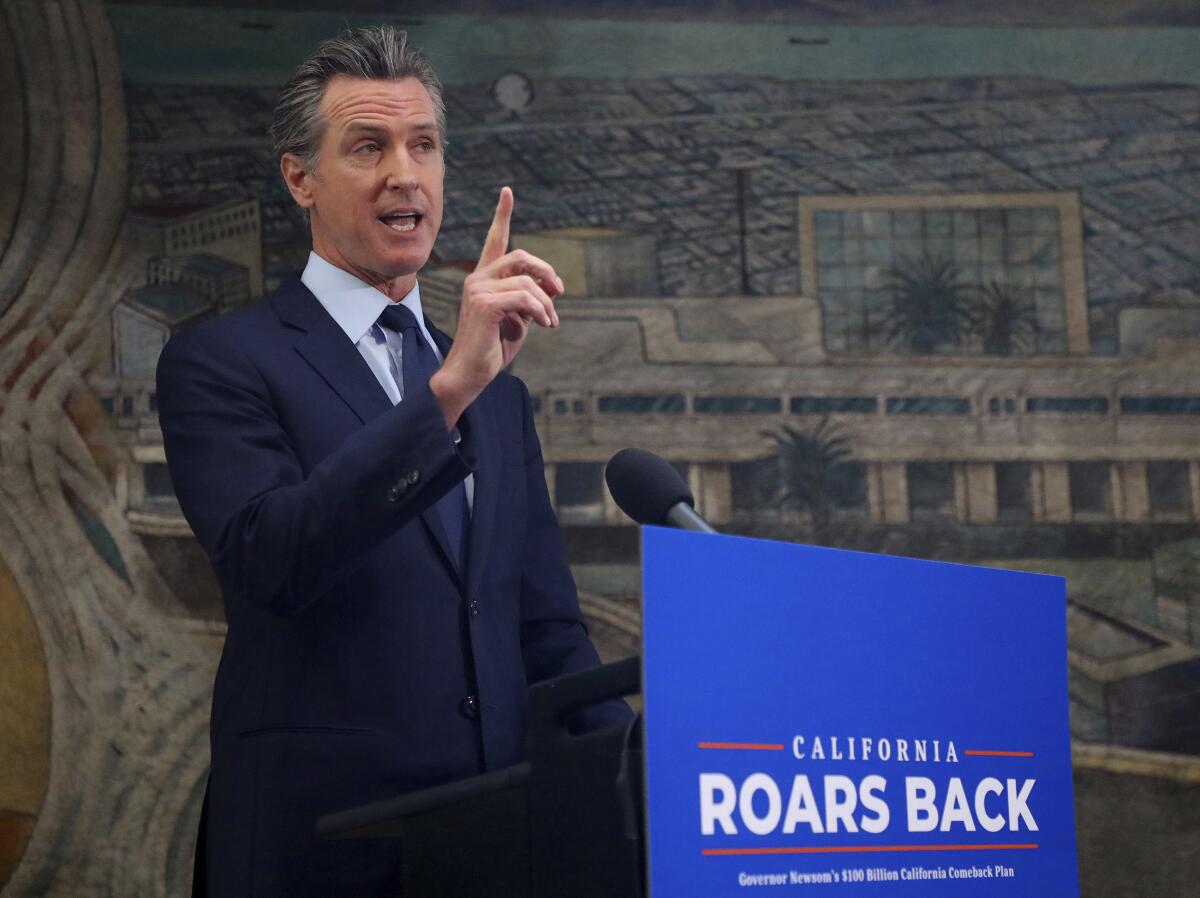Column: Newsom gets to play Santa Claus to California voters while Gray Davis was the grinch

- Share via
SACRAMENTO — It’s Christmas in May and Gov. Gavin Newsom is playing Santa Claus. The tree where all his gift-wrapped packages are piled is the state vault.
The vault is overflowing like never before.
Santa is flying around California promising expensive presents to voters who very likely will be deciding in a fall recall election whether to keep or toss him.
“It’s easier being Santa Claus than the Grim Reaper,” notes Democratic consultant Steve Maviglio, who was Gov. Gray Davis’ communications director when he was recalled in 2003 and replaced with Republican Arnold Schwarzenegger.
Davis was forced to play the Grim Reaper. That’s when the vault was draining and the state budget badly leaking red ink.
“We were cutting human services and education programs right and left,” Maviglio recalls. “That’s why we angered many Democrats in the Legislature. We also angered the right by raising the vehicle license fee and reinstating other fees that we had cut.
“Newsom’s situation is just the opposite. He can dole out money beyond anyone’s expectations.”
Newsom on Monday reported an eye-popping, unprecedented projected state budget surplus of $75.7 billion. Of that, $38 billion is discretionary general fund play money. Most of the rest, $26.6 billion, is targeted for K-12 schools and community colleges. Roughly $11 billion will be dumped into a rainy day fund or spent on debt repayment.
On top of that, the state expects to receive $26 billion in stimulus largess from the federal government.
But who really knows? A year ago, the Newsom administration was projecting a $54-billion deficit because of the pandemic. Turns out, upper-middle-class and wealthy taxpayers had a good year and paid more taxes than state experts expected.
“Politicians love giving away money,” says Republican consultant Rob Stutzman, who was Schwarzenegger’s communications strategist in 2003. “This helps Newsom with the recall.”
But there’s one potential downside, Stutzman adds.
“When you’re spending so much money, it highlights who’s not being paid, and you can become vulnerable.”
One example: The highest-income taxpayers who built most of the gargantuan surplus. They’re not getting any of Newsom’s so-called tax rebate and had every reason to expect that they would under the law.
This isn’t an argument about the merits of what Newsom proposed — $600 “rebate” checks for people earning less than $75,000 annually — but a question concerning whether it fits within the letter of the law.
It certainly doesn’t mesh with the spirit of Proposition 4, which voters overwhelmingly approved in 1979, a follow-up to their enactment of property tax-cutting Proposition 13 the year before. Proposition 4 was commonly called the Gann Limit, named for its sponsor, Paul Gann, who was a coauthor of Proposition 13.
Under the Gann initiative, state spending was limited by inflation and population growth. And if the limit was reached, the law decreed that the surplus money “shall be returned” to taxpayers “by a revision of tax rates or fee schedules.” The law was later amended to split the surplus 50-50 between taxpayers and schools.
Only once before, in 1987, has the limit been reached and a rebate triggered. Republican Gov. George Deukmejian and the Democrat-controlled Legislature reached a compromise within both the letter and spirit of the law.
Everyone who filed a tax return — whether they didn’t pay any tax or were in the top 1% of earners — got a rebate. Single people got checks of at least $32 and couples $64. Above that, people received rebates equal to 15% of their tax liability, up to a maximum of $118 for a single person and $236 for couples.
Something for everyone. Democratic leaders objected, but there was a Republican governor — a big difference from today’s one-party rule.
Then-Controller Gray Davis made sure the checks were mailed in time for Christmas.
The proposal to deliver $8 billion in new cash payments to millions of Californians amid the COVID-19 pandemic is part of a $100-billion state budget that has swelled with a significant windfall of tax revenues.
Newsom estimates that the state is spending $16 billion above the Gann Limit and is proposing that $8 billion be “rebated.” Tax filers earning between $30,000 and $75,000 would receive a $600 check. People earning less than $30,000 already have gotten $600 checks from a previous state stimulus program.
All people earning less than $75,000 with a dependent would receive an additional $500.
Newsom called it “the largest tax rebate in U.S. history.”
But this is more like another spending program — a stimulus program — than a tax rebate.
A rebate is when you buy something — or pay a tax — and get back a portion.
Newsom said two-thirds of Californians will receive the checks, which means one-third will be frozen out. The top fifth of taxpayers provide nearly 90% of the state income tax, which accounts for two-thirds of the general fund revenue. There’ll be no rebate for them.
That wasn’t what voters were told when they approved the Gann Limit.
“This isn’t a tax rebate as much as it is a tax transfer,” says Dan Schnur, a USC and UC Berkeley political communications instructor who once was a Republican operative. “The constitutional grounds are questionable. It’s a lawsuit waiting to happen.”
But Newsom’s budget writers say that the Gann language is broad and the governor’s proposal “satisfies” the law.
“It says the surplus has to be returned to taxpayers,” Finance Department spokesman H.D. Palmer says. “It doesn’t stipulate how you do that.”
The governor believes he can do that by playing Santa for those most in need. Fine. Just don’t pretend it’s a rebate.
More to Read
Sign up for Essential California
The most important California stories and recommendations in your inbox every morning.
You may occasionally receive promotional content from the Los Angeles Times.












